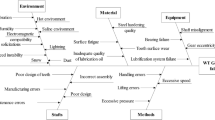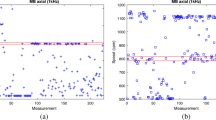Abstract
To detect wind turbine faults at an early stage, an investigation into a practical maintenance and repair approach was carried out on Jeju Island, South Korea. A condition monitoring system was installed in each wind turbine nacelle to detect the vibration signals from the gearbox and the generator. The vibration signals were measured by strain gauges on the gearbox and the generator for a period of approximately one to two years. A time domain analysis to detect the components’ faults was performed, and a frequency domain analysis was conducted to find the location of the faults that occurred. Using the criteria of acceptance level for the root mean square suggested in Verein Deutscher Ingenieure standard 3834, it was determined whether or not the gearbox and the generator were operated normally. After a fault was detected by root mean square analysis, the fast fourier transform spectrum was analyzed and then compared with that suggested by the International Organization for Standardization standard 10816–21 and 13373–1. Repair work was then conducted on the defective parts of the components. The root mean square and the acceleration value of the normal, the warning and the abnormal conditions were compared with one another. As a result, cavitation might occur in the gear oil pump attached to the gearbox due to the high acceleration values observed for frequencies ranging from 5000 Hz to 11000 Hz. Additionally, the generator bearing at the non drive end was found to be broken because the defect frequency of the bearing was 88 Hz, which was derived from envelope spectrum analysis. The root mean square and the acceleration values for the gearbox and the generator decreased to values indicating normal operating conditions after the damage repair. The annual energy production increased by 1.8 % after the generator bearing repair.
Similar content being viewed by others
References
W. Y. Liu and B. P. Tang, The structure healthy condition monitoring and fault diagnosis methods in wind turbines: A review, Renewable and Sustainable Energy Reviews, 44 (2015) 466–472.
J. Ribrant, Reliability performance and maintenance–A survey of failures in wind power systems, KTH School of Electrical Engineering (2006).
F. Cheng, Fault prognosis and remaining useful life prediction of wind turbine gearboxes using current signal analysis, IEEE Transactions on Sustainable Energy, 9 (2018).
Z. Zhang, A. Verma and A. Kusiak, Fault analysis and condition monitoring of the wind turbine gearbox, IEEE Transactions on Energy Conversion, 27 (2012) 526–535.
P. Guo, D. Infield and X. Yang, Wind turbine generator condition–monitoring using temperature trend analysis, IEEE Transactions on Sustainable Energy, 3 (2012) 124–133.
W. Teng, X. Ding and Y. Zhang, Application of cyclic coherence function to bearing fault detection in a wind turbine generator under electromagnetic vibration, Mechanical System and Signal Processing, 87 (2017) 279–293.
J. Igba, K. Alemzadeh and C. Durugbo, Analysing RMS and peak values of vibration signals for condition monitoring of wind turbine gearboxes, Renewable Energy, 91 (2016) 90–106.
M. R. Uma and R. Umamaheswari, Trends in non–stationary signal processing techniques applied to vibration analysis of wind turbine drive train–A contemporary survey, Mechanical Systems and Signal Processing, 85 (2017) 296–311.
W. Yang, R. Court and P. J. Tavner, Bivariate empirical mode decomposition and its contribution to wind turbine condition monitoring, Journal of Sound and Vibration, 330 (2011) 3766–3782.
W. Yang, C. Little and P. J. Tavner, Data–driven technique for interpreting wind turbine condition monitoring signals, IET Renewable Power Generation, 8 (2014) 151–159.
W. Yang, C. Little and R. Court, S–Transform and its contribution to wind turbine condition monitoring, Renewable Energy, 62 (2014) 137–146.
W. Yang, P. J. Tavner and W. Tian, Wind turbine condition monitoring based on an improved spline–kernelled chirplet transform, IEEE Transactions on Industrial Electronics, 62 (2015) 6565–6574.
Y. R. Hwang, K. K. Jen and Y. T. Shen, Application of cepstrum and neural network to bearing fault detection, Journal of Mechanical Science and Technology, 23 (2009) 2730–2737.
I. Antoniadou, G. Manson and W. J. Staszewski, A time–frequency analysis approach for condition monitoring of a wind turbine gearbox under varying load conditions, Mechanical Systems and Signal Processing, 64–65 (2015) 188–216.
WindPRO v3.1,Simulation Program WTG Data Catalogue.
I. Howard, A review of rolling element bearing vibration "detection, diagnosis and prognosis", Aeronautical and Maritime Research Laboratory Airframes and Engines Division (1994).
B. P. Graney and K. Starry, Rolling element bearing analysis, The American Society for Nondestructive Testing, Inc, 70 (2011) 78–85.
X. Zhu and Y. Zhang, Intelligent fault diagnosis of rolling bearings based on kernel neighborhood rough sets and statistical features, Journal of Mechanical Science and Technology, 26 (2012) 2649–2657.
VDI standard 3834, Measurement and Evaluation of The Mechanical Vibration of Wind Turbines and Their Components, Verein Deutscher Ingenieure (2015).
ISO standard 10816–21, Mechanical vibration–Evaluation of machine vibration by measurements on non–rotating parts–Part 21: Horizontal axis wind turbines with gearbox (2015).
ISO standard 13373–1, Condition monitoring and diagnostics of machines–Vibration condition monitoring–Part 1: General procedures (2004).
I. Tzanakis, G. S. B. Lebon and D. G. Eskin, Characterizing the cavitation development and acoustic spectrum in various liquids, Ultrasonics Sonochemistry, 34 (2017) 651–662.
N. Zhang, M. Yang and B. Gao, Vibration characteristics induced by cavitation in a centrifugal pump with slope volute, Hindawi Publishing Corporation Shock and Vibration (2015).
E. Hiroaki and S. Nader, Gearbox simulation models with gear and bearing faults, Prince Mohammad Bin Fahd University (PMU) (2012) 20–55.
Y. J Park, J. G Kim and G. H Lee, Load sharing and distributed on the gear flank of wind turbine planetary gearbox, Journal of Mechanical Science and Technology, 29 (2015) 309–316.
D. Howieson, Vibration monitoring: Envelope signal processing–Using envelope signal processing in vibration monitoring of rolling element bearings, SKF Reliability Systems aptitudeXchange (2003).
R. Rubini and U. Meneghetti, Application of the envelope and wavelet transform analyses for the diagnosis of incipient faults in ball bearings, Mechanical Systems and Signal Processing, 15 (2001) 287–302.
D. H, Shin, H. W. Kim and K. N. Ko, Analysis of wind turbine degradation via the nacelle transfer function, Journal of Mechanical Science and Technology, 29 (2015) 4003–4010.
IEC, Wind turbine generator systems Part 12–1: Power performance measurements of electricity producing wind turbines, Second Ed., IEC 61400–12–1 (2005).
Author information
Authors and Affiliations
Corresponding author
Additional information
Recommended by Associate Editor Daeil Kwon
Jinhyuk Son is a Ph.D. candidate of the Multidisciplinary Graduate School Program for Wind Energy in Jeju University, Republic of Korea. He holds a bachelor’s degree (2015) in New Material Engineering from Gyeongsang University and a master’s degree (2017) from the Faculty of Wind Energy Engineering, Graduate School, Jeju University. He has been studying on the condition monitoring system of wind turbines. In addition, he is interested in prediction for life time of wind turbine components.
Dongbum Kang is a Ph.D. candidate of the Multidisciplinary Graduate School Program for Wind Energy in Jeju University, Republic of Korea. He holds a bachelor’s degree (2009) in Physical education and a master’s degree (2015) from the Faculty of Wind Energy Engineering, Graduate School, Jeju University. He has been studying on wind resource assessment and the condition monitoring system of wind turbines.
Kyungnam Ko is an Associate Professor of the Faculty of Wind Energy Engineering, Graduate School, Jeju University, Republic of Korea. He earned a bachelor’s degree in Marine Engineering in 1993 and a master’s degree in Mechanical Engineering in 1995 at Jeju University. He then received his Ph.D. degree in Mechanical System Engineering in 2002 from Gunma University, Japan. He has been studying on wind resource assessment, wind farm design, condition monitoring system and power curves of wind turbines. Furthermore, his research interest includes economic feasibility analysis.
Rights and permissions
About this article
Cite this article
Son, J., Kang, D., Boo, D. et al. An experimental study on the fault diagnosis of wind turbines through a condition monitoring system. J Mech Sci Technol 32, 5573–5582 (2018). https://doi.org/10.1007/s12206-018-1103-y
Received:
Revised:
Accepted:
Published:
Issue Date:
DOI: https://doi.org/10.1007/s12206-018-1103-y




